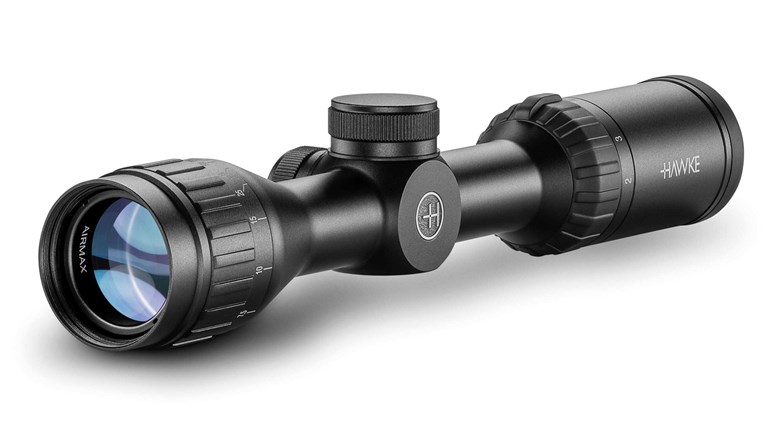
This review of the Steiner PX4i 1-4x24mm optic appeared originally as a Gun Locker review in the August 2017 issue of Shooting Illustrated. To subscribe to the magazine, visit the NRA membership page here and select Shooting Illustrated as your member magazine.
Tactical optics like the Steiner PX4i 1-4x24 riflescope have come a long way in a relatively short time period. A decade ago, for example, the choices for a tactical optic tended to be a red-dot optic—usually without magnification—or a 5-25X behemoth that cost more than a few house payments.
But, many of today’s low- to mid-range tactical scopes not only provide actual magnification; they come with superior lens coatings, illuminated reticles and main tubes built to take some abuse. And as the image quality and clarity of these optics have improved, many tactical shooters have also realized they don’t need spotting-scope-level magnification to get the job done at distance. A 1-6X and yes, even a 1-4X, will do very well for mid-range shooting and even a bit farther.
The new Steiner P4Xi 1-4x24 tactical scope is a great example of the quality and features that can be had in a compact tactical optic. And the company has a model that doesn’t require several thousand dollars at the cash register, either. The P4Xi is a quality second-focal-plane optic that presents very clear images. Turret adjustments are precise and the scope features a supremely functional illuminated reticle, making the P4Xi a fine choice for self-defense, 3-gun-type competitions and law enforcement applications.

I attached the new Steiner P4Xi 1-4x24 riflescope to my Bushmaster Minimalist-SD rifle, chambered in .300 BLK, using a DLOC-M4-30 mm mount made by ZRO Delta. I took the Steiner-Minimalist rig to my local outdoor shooting range and tried out the rifle and scope using three different brands of ammunition.
I started by zeroing the scope at 50 yards, with the P4Xi set at 4X. My first shots hit several inches low and to the right. Each click for elevation and windage adjustment equals .5 MOA at 100 yards; I moved my point-of-impact up and over to the bullseye within six shots and just a few adjustments. The turrets turned easily—maybe even a bit too easily, given that I am used to scopes with turrets requiring a more pronounced torquing. But, I soon got used to the easy clicks. I switched to 100-yard targets. Here, the rifle initially grouped low, and a few clicks put me right in the bullseye. I fired off 10 shots once the rifle was zeroed, as much to get a feel for the rifle as for the scope.
Steiner’s P3TR Reticle is essentially a BDC reticle calibrated to work with both 5.56 and 7.62 NATO, with stadia lines for 200-, 300-, 400- and 500-yard distances. The reticle is also illuminated, and offers 11 different levels of brightness (five daytime, four low-light and two night-vision settings), with an “off” position between each setting.

My shooting table put me on the line with access to both my 50- and 100-yard targets. So, while varying magnifications from lowest to highest, I popped off rounds fast and furious, swinging from the 50-yard target to the 100 yarder, and then in reverse. No matter the magnification, I got on target fast, thanks in part to the great clarity the Steiner P4Xi 1-4x24 optic provided. The illuminated reticle was a huge help here, too—it got me on the bullseye quickly, without being so bright as to obscure the bullseye itself.
 Then I did the standard scope-box test. (Or, in my case, more of a rectangle test.) Using a new target set up at 100 yards, I fired off two rounds at the bullseye, and made both hits very near the center. Then, I spun the windage-turret adjustment 10 clicks to the right and fired two rounds (aiming at the bullseye), then eight clicks up on the elevation, and two rounds downrange. Then, 10 clicks to the right and fired, and ended with eight clicks down, and two more rounds. My final two shots landed right next to my initial two bullseye hits, and the other six rounds had made a rectangle on the target—a ragged one I must admit, as I have a tough time firing slow and patient with an AR. Yet, the click calibrations moved the point-of-impact over and up and back and down very nicely.
Then I did the standard scope-box test. (Or, in my case, more of a rectangle test.) Using a new target set up at 100 yards, I fired off two rounds at the bullseye, and made both hits very near the center. Then, I spun the windage-turret adjustment 10 clicks to the right and fired two rounds (aiming at the bullseye), then eight clicks up on the elevation, and two rounds downrange. Then, 10 clicks to the right and fired, and ended with eight clicks down, and two more rounds. My final two shots landed right next to my initial two bullseye hits, and the other six rounds had made a rectangle on the target—a ragged one I must admit, as I have a tough time firing slow and patient with an AR. Yet, the click calibrations moved the point-of-impact over and up and back and down very nicely.
Lightweight and easy to use, the Steiner P4Xi 1-4x24 scope will be a first-rate choice for patrol rifles and AR platforms. Priced less than $600, you can’t ask much more from a quality piece of tactical shooting glass.






































